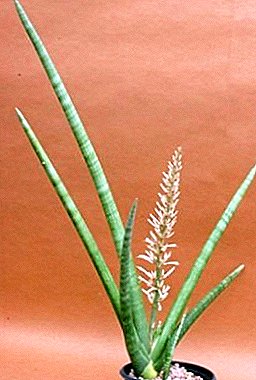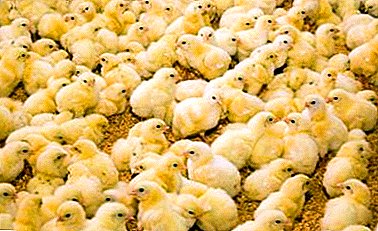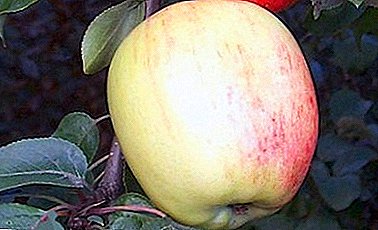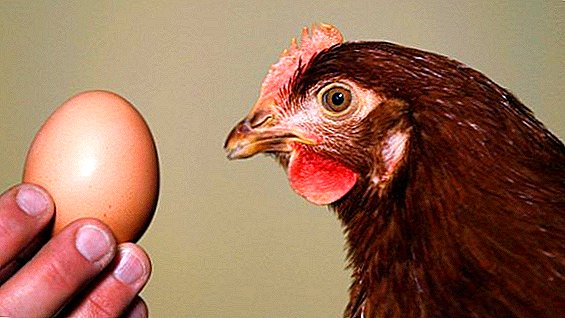 Each poultry farmer must choose a breed of chickens based on their goals. If he plans to sell meat or grow birds for his own use, then you need to pay attention to meat breeds. If the main goal is to get eggs, then chicken should be purchased egg direction. You can solve two problems at the same time, taking on the content of universal layers. In the article we will talk about the features of the egg production of various breeds of chickens: you will learn what needs to be done to increase the productivity of birds, how old it is at its peak, and what diseases can reduce it.
Each poultry farmer must choose a breed of chickens based on their goals. If he plans to sell meat or grow birds for his own use, then you need to pay attention to meat breeds. If the main goal is to get eggs, then chicken should be purchased egg direction. You can solve two problems at the same time, taking on the content of universal layers. In the article we will talk about the features of the egg production of various breeds of chickens: you will learn what needs to be done to increase the productivity of birds, how old it is at its peak, and what diseases can reduce it.
Breeds of chickens
All chickens are divided into three types: meat, egg and universal (meat-egg). We have selected for you a description of 5 breeds in each of the categories that are characterized by the highest egg production.
Meat Chicken
Meat chickens stand out for their large size, large mass and good quality meat. As a rule, these are sedentary birds that spend very little energy, which is why they gain weight well. Rooster meat can weigh up to 5.5 kg, layers - up to 4.5 kg.  The latter have a good nasizhivaniya instinct and maternal instinct. Meat chickens have a later puberty than other species. They can multiply from 7-8 months. And of course, they cannot boast egg production. The average number of eggs per year is 80-120 pieces.
The latter have a good nasizhivaniya instinct and maternal instinct. Meat chickens have a later puberty than other species. They can multiply from 7-8 months. And of course, they cannot boast egg production. The average number of eggs per year is 80-120 pieces.
The most popular breeds of meat among birds today are:
- Brama;
- Cochinquin;
- Cornish;
- Gudan;
- Fireball
 Adult Cocks Cochinquin weigh 3.5–5.5 kg each; hens weigh 3.5–4.5 kg each. Representatives of this breed have different colors - black, white, bronze, blue, fawn, partridge and others. Efficiency per year - 100-120 eggs with a weight of 50-60 g.
Adult Cocks Cochinquin weigh 3.5–5.5 kg each; hens weigh 3.5–4.5 kg each. Representatives of this breed have different colors - black, white, bronze, blue, fawn, partridge and others. Efficiency per year - 100-120 eggs with a weight of 50-60 g.  Male Cornish breed reach a mass of 5 kg, women - 3.5 kg. The most common white Cornish, but you can also find dark, fawn, red. Egg laying hens - up to 110-140 pieces weighing 55-60 g.
Male Cornish breed reach a mass of 5 kg, women - 3.5 kg. The most common white Cornish, but you can also find dark, fawn, red. Egg laying hens - up to 110-140 pieces weighing 55-60 g.  Goodies gaining a mass of 2.5 kg - layers, and 3 kg - roosters. The color typical of them is black with white spots. Average annual egg production - up to 160 eggs. The weight of one is 50-55 g.
Goodies gaining a mass of 2.5 kg - layers, and 3 kg - roosters. The color typical of them is black with white spots. Average annual egg production - up to 160 eggs. The weight of one is 50-55 g.  Representatives of the breed Fireball gain up to 2.5-4 kg. Their colors are different: the most common are silver and salmon. In the year one layer is able to bring 160-180 eggs weighing 55-60 g.
Representatives of the breed Fireball gain up to 2.5-4 kg. Their colors are different: the most common are silver and salmon. In the year one layer is able to bring 160-180 eggs weighing 55-60 g. 
Egg hens
As the name implies, individuals of the egg direction are valued because of the high level of egg production and the large mass of eggs. These chickens, as a rule, do not exceed the weight of 2.5 kg. Characterized by precocity, early puberty and the absence of incubation instinct.
Did you know? In the Guinness Book of Records fell a layer of breed Leggorn, which in 1956 brought an egg weighing 454 g, despite the fact that its relatives are able to lay eggs for 60-70 g.
The best among the egg species are:
- Leggorn;
- Hisex Brown;
- Loman Brown;
- Isa Brown;
- High Line.
 Hisex Brown have a small body weight - up to 2 kg. Their egg production is 300-320 eggs per year, the mass of one is 63-65 g. High productivity lasts for two or three years.
Hisex Brown have a small body weight - up to 2 kg. Their egg production is 300-320 eggs per year, the mass of one is 63-65 g. High productivity lasts for two or three years.  Lohman Brown representatives - small poultry in size and mass. They gain about 1.5 kg. Their feather color is light brown. Egg production is high - up to 320 pieces per year. The average weight of one piece is 60-64 g.
Lohman Brown representatives - small poultry in size and mass. They gain about 1.5 kg. Their feather color is light brown. Egg production is high - up to 320 pieces per year. The average weight of one piece is 60-64 g.  Layers Isa Brown reach a maximum weight of 1.9 kg. The hen of this breed is able to lay about 320 eggs per year with an average weight of 63 g.
Layers Isa Brown reach a maximum weight of 1.9 kg. The hen of this breed is able to lay about 320 eggs per year with an average weight of 63 g.  High line - birds with a body weighing up to 1.5 kg, covered with white and brown plumage. One laying of 365 days gives up to 340 eggs with a maximum weight of 65 g.
High line - birds with a body weighing up to 1.5 kg, covered with white and brown plumage. One laying of 365 days gives up to 340 eggs with a maximum weight of 65 g.
Important! The level of egg production is influenced by such factors as the age of the chicken, the state of health, the conditions of its housing, a balanced diet with sufficient content of proteins and calcium, the time of the year.
Universal Chickens
Hens of the universal direction are received as a result of crossing of birds with good egg production and excellent quality of meat. They are grown in the event that they want to have from a layer of eggs and meat. Their egg production is good - not less than 200 pieces, and the quality of meat is high. Representatives of this direction to the same great mothers.
The best in this category are:
- Australorp;
- Foxy Chick;
- Plymouth Rock;
- Rhode Island;
- Kuchinsky anniversary.
 Foxy Chick Chicken grow up to 3.5-4 kg, roosters - up to 5-7 kg. One layer delivers about 250 eggs per year. Mass of one - 65-70 g.
Foxy Chick Chicken grow up to 3.5-4 kg, roosters - up to 5-7 kg. One layer delivers about 250 eggs per year. Mass of one - 65-70 g.  Roosters Plymouth Characterized by weight up to 5 kg, hens - up to 3-3.5 kg. The average annual egg production of the breed is 170 pieces. The weight of one piece is 55-60 g.
Roosters Plymouth Characterized by weight up to 5 kg, hens - up to 3-3.5 kg. The average annual egg production of the breed is 170 pieces. The weight of one piece is 55-60 g.  Rhode Islands Adults weigh from 2.5 to 4 kg, give up to 170 eggs weighing 60 g.
Rhode Islands Adults weigh from 2.5 to 4 kg, give up to 170 eggs weighing 60 g.  Kuchinsky anniversary about 200 eggs per year. The mass of one of them is 55-60 g. The meat productivity of hens is 2.5-3 kg, of roosters - up to 4 kg.
Kuchinsky anniversary about 200 eggs per year. The mass of one of them is 55-60 g. The meat productivity of hens is 2.5-3 kg, of roosters - up to 4 kg. 
Did you know? Today, chicken leggorn is considered the record holder for the number of eggs laid per year. Over 365 days she laid 371 eggs. The record was recorded in 1976. Leggornu also owns a few more achievements. So, in 1956 a representative of this breed laid an egg weighing 454 g. And in 1971 an egg with 9 yolks was recorded in a Laygorn hen.
At what age do chickens begin to trot
So, each of the species begins to be carried in different ways. So, from the representatives of the meat direction you should wait for the first eggs from 7-8, or even from 9 months (Gudan and Faverol - from 6). Egg hens begin to delight their host with tasty eggs from 4-5 months. Meat-egg birds enter egg production from 5-6 months.
Video: when chickens start laying eggs
How many eggs can a chicken carry?
Let's calculate what egg production can be expected from representatives of different directions for a certain time period.
In a day
Chicken is not steadily steadily every day. The indicator when the Layhorn layer laid 361 eggs in 365 days is an exception. A bird can take down 1 egg, for example, in 2-3 days. Continuously one layer with annual egg production 300 pieces can be carried for 50-60 days with an interval of 2 days. Those who carry over 300 pieces per year, are able to continuously lay 40-80 eggs with a small interval.
Find out why chickens do not carry eggs, whether chicken eggs are useful, what vitamins chicken hens need for egg production and why chickens peck eggs.
In Week
On average, 4-5 eggs per week can be expected from one layer of egg production, maximum - 6, from meat breeds - 2-3 pieces, from universal ones - 3-4 pieces. This indicator can be achieved only in the summer, when egg production reaches its peak, and under optimal conditions of detention, including a balanced diet. 
Per month
The monthly egg production rate of one egg layer is 15–26 eggs, meat –– 10–13, meat –– 13–15. It is worth noting that in the summer months the birds rush, as a rule, every other day, in the winter, during the molting period - much less often, and some breeds do not do it at all.
In year
In the year, representatives of meat breeds rush from 120 to 150 times, egg breeds - 200-250 times, universal - 160-200 times.
Important! Egg production decreases sharply or falls completely during periods of molting and hatching. By providing the necessary conditions in the hen house, it can be achieved that during the winter period its decline will not occur.
Video: how many eggs can a chicken carry
Do I need a rooster?
For many, it will surely be a discovery that in order for the hen to lay eggs, she does not need a rooster. In laying hens the maturation of the egg occurs regardless of whether there is a rooster in the henhouse or not. But when fertilization and the birth of chickens are required, of course, one cannot do without a male specimen. Unfertilized eggs, which are used in food, are no different from fertilized either in appearance or taste, or in the content of nutrients. 
How to increase egg production
In order for the chicken to consistently carry the maximum possible number of eggs, certain conditions should be created for it:
- daylight hours are not shorter than 12 and no longer than 14 hours - there should be at least one window in the hen house for daylight penetration and an additional source of illumination in winter (preferably a daylight lamp);
- it is warm - in a warm coop, the hens are more eager than in a cool one, so in winter it is necessary to ensure that the temperature does not fall below + 15 ° C. Care should be taken to install heaters;
- air humidity at the level of 60-70% - with indicators below or above the hen, they feel uncomfortable;
- population density in the house is not higher than 4-6 layers per 1 square meter. m;
- providing daily walking to birds;
- compliance with sanitary standards in the house;
- organization of high-quality ventilation.
Video: how to increase egg production in chickens
Feed for improved egg production
One of the main factors of high productivity in birds is a balanced diet that contains proteins, fats, carbohydrates, vitamins and minerals.
In the hen menu must necessarily include:
- grain (wheat, barley, oats, corn);
- vegetables (potatoes, carrots, beets, cabbage);
- greens (nettle, dandelion, alfalfa, clover);
- mineral supplements (calcium, phosphorus, sodium, chlorine);
- vitamins.
Learn how to feed chickens in the winter to improve egg production.
An approximate daily chicken menu might look like this:
- grain - 120 g;
- wet mash - 30 g;
- boiled potatoes - 100 g;
- cake - 7 g;
- chalk - 3 g;
- salt - 0.5 g;
- bone meal - 2 g;
- yeast - 1 g
 You can also make bran, crushed shells, salt, waste from the table. For lunch they feed them with mushrooms, vegetables and greens. In the evening - time for cereals, which should be changed daily. Evening feeding is carried out no later than an hour before the birds climb to roost. It is important not to overfeed or underfeed the bird.
You can also make bran, crushed shells, salt, waste from the table. For lunch they feed them with mushrooms, vegetables and greens. In the evening - time for cereals, which should be changed daily. Evening feeding is carried out no later than an hour before the birds climb to roost. It is important not to overfeed or underfeed the bird.Important! A layer weighing 2 kg and with an average egg production rate 100 eggs will need 130 g of feed per day. For every additional 250 g of weight, add 10 g of feed.
There are 2 more mandatory conditions:
- the constant availability of clean water;
- gravel for better digestion.
How many years can the chicken
Usually, the height of the productivity of the hen falls in the first year of egg production. In the future, each year it is reduced by 15-20%. At the same time, there is an increase in the mass and size of eggs. At the age of three, as a rule, the chicken is no longer able to be productive, it often begins to hurt.  In industrial production it is customary to use chickens for 52 weeks of the productive period and 70 weeks of life. Farmers prefer to keep the hen no more than 3 years.
In industrial production it is customary to use chickens for 52 weeks of the productive period and 70 weeks of life. Farmers prefer to keep the hen no more than 3 years.
Diseases that reduce egg production
Of course, the level of egg production primarily depends on the health of the hen. Unfortunately, chickens can overtake a number of diseases, because of which they either begin to carry few eggs, or stop doing it altogether. This is the effect of infectious diseases: infectious bronchitis, colibacteriosis, mycoplasmosis, laryngotracheitis.
In case of violation of the zoohygienic regime in the hen house, hens may suffer from hyperthermia, bronchopneumonia, and colds. All these diseases can also significantly reduce the number of eggs laid by a hen, or reduce them to zero.
Read also about how to overcome the virus egg drop syndrome.
The unbalanced diet and the problems behind it in the form of avitaminosis, lack of proteins and calcium, cloacite and cannibalism lead to disruption of the egg-laying process. The lack of any element and a sedentary lifestyle threaten the occurrence of problems with the oviduct and the difficulty of egg-laying.  Overfeeding is fraught with the development of yolk peritonitis. Poor quality food can also cause inflammation of the oviduct. In addition to diseases, a decrease or absence of egg production may occur for the following reasons:
Overfeeding is fraught with the development of yolk peritonitis. Poor quality food can also cause inflammation of the oviduct. In addition to diseases, a decrease or absence of egg production may occur for the following reasons:
- bad light;
- insufficient, poor or excessive nutrition;
- lack of water;
- periods of molting, hatching;
- non-compliance with the temperature, humidity, aeration regime in the hen house, temperature jumps, overcrowding;
- changing the location of the nests.
Thus, the egg production is influenced by many factors: the breed of chickens, the conditions of their housing, the season, the health of the bird, its age, the diet. The first thing that needs to be done while reducing egg production is to improve the quality of the feeding of the hens, bring the light level back to normal, pay attention to the conditions in the chicken coop and the health status of the birds.












